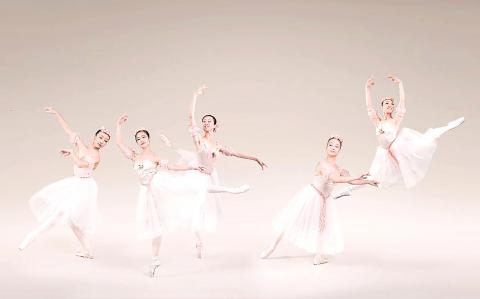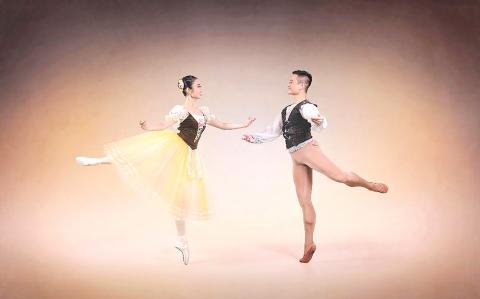While balletomanes are familiar with the names Giselle, La Sylphide, Pas de Quatre, August Bournonville, Jean Coralli, Jules Perrot, Marius Petipa, others outside the dance world might not be. Kaohsiung City Ballet (KCB, 高雄城市芭蕾舞團) founder and artistic director Chang Hsiu-ru (張秀如) wants to rectify that situation.
With this latest production she focuses on several of the romantic works from the 19th century that not only remain in the repertoire of ballet companies the world over, but are considered to have been crucial to the development of ballet.
For help with this project, she turned once again to Romanian dancer/choreographer/multimedia artist Constantin Georgescu, who began working with the company for its 2014 production of Coppelia, another 19th century romantic classic.

Photo courtesy of Liu Ren-haur
The show, 19th Century Romanic Ballets (世紀浪漫芭蕾—仙女—吉賽兒—四人舞), premieres on Saturday at the Kaohsiung Cultural Center, followed by two more shows, one in Pingtung County the following Saturday and then at the Taichung National Theater on Sept. 11.
Linking the works — La Sylphide, Giselle and Pas de Quatre — together is not just their age, but that the versions dance lovers know today are actually recreations by other famous choreographers, because either the original versions were lost or later recreations became more famous.
For example, Milan-born Filippo Taglioni first created La Sylphide — a story about young love and fairies, set in Scotland — to showcase the talents of his daughter, Marie Taglioni, and the production, which premiered at the Paris Opera on March 12, 1832, was the first to make pointe work a key focus of the choreography. The score was by Jean-Madeleine Schneitzhoeffer.

Photo courtesy of Liu Ten-hour
However, the version of La Sylphide that most people know today is by Danish ballet master Bournonville, who wanted to restage Taglioni’s work, but the Paris Opera wanted to much money for the rights to Schneitzhoeffer’s score, so Bournonville created his own version for the Royal Danish Ballet to a score by Herman Severin Lovenskiold.
His 1836 version remains in the Royal Danish’s repertoire and is considered the one of the oldest surviving ballets.
Pas de Quatre, which was choreographed by Perrot, premiered in London on July 12, 1845, is not a full-length ballet, but a divertissement. Its claim to fame lies in that Perrot centered the choreography on four of the most famous ballerinas of the time: Maria Taglioni, Fanny Cerrito, Carlotta Grisi and Lucille Grahn, putting them onstage together for the first time. The show was a huge success and a lithograph of the four ballerinas posing in their costumes became iconic.
However, Perrot’s original choreography was lost over the years, so what dancers and ballet goers know now is a 1941 version created by British choreographer Anton Dolin for four well-known ballerinas in London.
Giselle was created by Coralli and Perrot, to a score by Adolphe Adam, with Grisi dancing the lead role at the Paris premiere on June 28, 1841. It was a huge success and became so popular that it was quickly staged around Europe, in Russia and in the US.
However, the version most performed today is based on a revised version choreographed by Petipa for the Imperial Ballet in St Petersburg in 1899.
As a dancer with the company, Petipa had helped Perrot, by then the ballet master at the Imperial Ballet, stage a revival of the work in 1850. Almost five decades later he made the work his own.
Georgescu said that his work on KCB’s show required the skills of an explorer, historian and dancer as he tried to find information about the works from original sources.
Then he faced the challenge of working with dancers from different schools and training them in the techniques needed for the very different works.
“How to achieve speed of foot work without losing the expressivity of the upper body” for what is known as the Bournonville style, was one challenge, he said.
Another was how to present the elegant, fluid arm movements of Pas de Quatre with what dancers are used to today, he said.
With the Giselle excerpts, he had to balance the demands of a crucial pas de deux between Giselle and Albrecht, and then the demands of for the “peasants” in a pas de deux and group dance.

“Why does Taiwan identity decline?”a group of researchers lead by University of Nevada political scientist Austin Wang (王宏恩) asked in a recent paper. After all, it is not difficult to explain the rise in Taiwanese identity after the early 1990s. But no model predicted its decline during the 2016-2018 period, they say. After testing various alternative explanations, Wang et al argue that the fall-off in Taiwanese identity during that period is related to voter hedging based on the performance of the Democratic Progressive Party (DPP). Since the DPP is perceived as the guardian of Taiwan identity, when it performs well,

The Taiwan People’s Party (TPP) on May 18 held a rally in Taichung to mark the anniversary of President William Lai’s (賴清德) inauguration on May 20. The title of the rally could be loosely translated to “May 18 recall fraudulent goods” (518退貨ㄌㄨㄚˋ!). Unlike in English, where the terms are the same, “recall” (退貨) in this context refers to product recalls due to damaged, defective or fraudulent merchandise, not the political recalls (罷免) currently dominating the headlines. I attended the rally to determine if the impression was correct that the TPP under party Chairman Huang Kuo-Chang (黃國昌) had little of a

At Computex 2025, Nvidia CEO Jensen Huang (黃仁勳) urged the government to subsidize AI. “All schools in Taiwan must integrate AI into their curricula,” he declared. A few months earlier, he said, “If I were a student today, I’d immediately start using tools like ChatGPT, Gemini Pro and Grok to learn, write and accelerate my thinking.” Huang sees the AI-bullet train leaving the station. And as one of its drivers, he’s worried about youth not getting on board — bad for their careers, and bad for his workforce. As a semiconductor supply-chain powerhouse and AI hub wannabe, Taiwan is seeing

Jade Mountain (玉山) — Taiwan’s highest peak — is the ultimate goal for those attempting a through-hike of the Mountains to Sea National Greenway (山海圳國家綠道), and that’s precisely where we’re headed in this final installment of a quartet of articles covering the Greenway. Picking up the trail at the Tsou tribal villages of Dabang and Tefuye, it’s worth stocking up on provisions before setting off, since — aside from the scant offerings available on the mountain’s Dongpu Lodge (東埔山莊) and Paiyun Lodge’s (排雲山莊) meal service — there’s nowhere to get food from here on out. TEFUYE HISTORIC TRAIL The journey recommences with